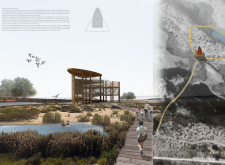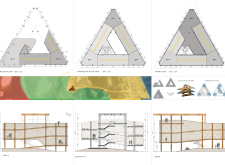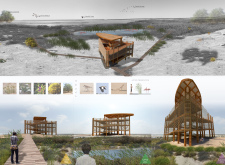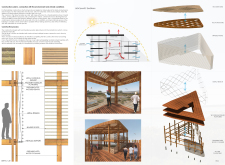5 key facts about this project
The structure features a modular design that prioritizes lightweight construction using sustainably sourced materials, particularly wood. The architectural form employs triangular shapes and dynamic roof structures reminiscent of sails or avian forms, contributing to both aesthetic appeal and practical benefits, such as wind resistance and efficient rainwater drainage. This configuration also aids in maximizing natural light and airflow throughout the building.
Unique Design Approaches
The design distinguishes itself through its use of modular wooden platforms that replace traditional circulation pathways, facilitating mobility for visitors while maintaining a connection with the environment. These platforms allow for unobstructed views and encourage interaction with the surrounding landscape. The incorporation of buffers between built areas and natural habitats showcases a deliberate effort to preserve local wildlife and vegetation.
Sustainability is further addressed through bioclimatic strategies that optimize energy use. The open layout encourages cross ventilation, while overhanging roofs provide passive cooling and glare reduction. These elements significantly reduce the reliance on mechanical heating and cooling systems, allowing the building to operate more sustainably.
Functional Zones and Key Areas
The project features distinct functional zones designed to cater to various user needs. Visitor areas are intuitively placed to offer optimal observation points, ideal for activities such as bird watching. Educational displays related to local flora and fauna enhance the learning environment, while service zones are strategically located to minimize disruption to public pathways.
Elevating visitor engagement, the design emphasizes a seamless flow between spaces, combining functionality with accessibility. The careful integration of architectural features and ecological considerations creates an inviting environment for exploration and discovery.
For a comprehensive understanding of this architectural design, interested readers are encouraged to explore additional details within the architectural plans, sections, and designs presented. Each element contributes to a deeper appreciation of the project's objectives and outcomes in relation to its ecological context.


























